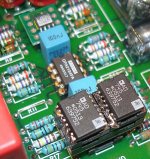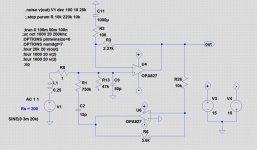Somebody I know like the AD745, ultra low noise JFET input opamp from Analog Devices.
Q1: Why only SOIC16 wide as the only package? Any clue? Before they had SOIC08 and DIIL08. I'll guess this has to do with market since it's rather old (1990).
Q2: Is this the best JFET opamp in the world in noise perspective?
Q3: Anybody why used this opamp lately besides Sigurd?
http://coset.se/tmp/Audio/Hagerman/OPampAdaptersNo011.jpg
http://www.audiocircle.com/circles/viewtopic.php?t=21339
Q1: Why only SOIC16 wide as the only package? Any clue? Before they had SOIC08 and DIIL08. I'll guess this has to do with market since it's rather old (1990).
Q2: Is this the best JFET opamp in the world in noise perspective?
Q3: Anybody why used this opamp lately besides Sigurd?
http://coset.se/tmp/Audio/Hagerman/OPampAdaptersNo011.jpg
http://www.audiocircle.com/circles/viewtopic.php?t=21339
die size? - the input fets alone take up more area than many complete op amps (i have old data book, die drawings have been removed from newer data sheets)
large area gives low channel R and low noise, fab process is also very important for 1/f noise corner
the low noise/large area input fet comes at a cost - large input C and distortion from fet parasitic C modulation with Vcm, balance +/- input Z, keep it low to minimize input distortion - or just use in inverting amps to avoid cm modulation
large area gives low channel R and low noise, fab process is also very important for 1/f noise corner
the low noise/large area input fet comes at a cost - large input C and distortion from fet parasitic C modulation with Vcm, balance +/- input Z, keep it low to minimize input distortion - or just use in inverting amps to avoid cm modulation
The AD745 is not out of program. I just ordered some 
I am not the only person who likes the AD745 a lot. Walt J is using it in his new book "OPamp Applications" on page 6.22 and 6.24.
Gary Galo is using it in his article about the Adcomp upgrade in audioXpress 2/04,
and he is also using it in his "Music Library Preamp" in audioXpress 3/05.
And of course I am using it in my Hagerman Superbugle
But I do not have an adapter for it
The AD745 has extremely low voltage noise at 2.9nV/srqt(Hz) and 6.9fA/sqrt(Hz) current noise,
and 0.0002% dist. 100uV typical DC offset (K-grade).
One of its main advantages is that it is made for higher gains and thus fits like a glove for RIAA amplifiers
Input C is about 18pF.
Sigurd
I am not the only person who likes the AD745 a lot. Walt J is using it in his new book "OPamp Applications" on page 6.22 and 6.24.
Gary Galo is using it in his article about the Adcomp upgrade in audioXpress 2/04,
and he is also using it in his "Music Library Preamp" in audioXpress 3/05.
And of course I am using it in my Hagerman Superbugle
But I do not have an adapter for it
The AD745 has extremely low voltage noise at 2.9nV/srqt(Hz) and 6.9fA/sqrt(Hz) current noise,
and 0.0002% dist. 100uV typical DC offset (K-grade).
One of its main advantages is that it is made for higher gains and thus fits like a glove for RIAA amplifiers
Input C is about 18pF.
Sigurd
Resurrecting this thread to talk about the AD745!
I'm currently building a phono preamp inspired by Walt Jung's 2-stage passive-EQ described in "The Op Amp Applications Handbook". Despite its age, the AD745 still looks devilishly attractive for this application!

All I'm doing differently, is using unity-gain buffers between stages, so I can use a lower impedance shunt network, and then no op amp needs to drive two loads. Each op amp only has one job; to drive either a load, or its own feedback network.
So there's a delicate balance with this topology. Because you're just wasting 40db at 20KHz into the shunt, the first stage op amp can only run at about 28db gain, so that the second stage doesn't overload before the first. At 20 KHz, they both clip.
The signal at 20KHz, out of the shunt network, is actually -12db from the input!
So the requirement is low noise at relatively low gain, and low distortion at low signal levels.
Anyways, I've come upon the OPA828 as being the more modern choice for this application, but Walt Jung's choices are so impeccable, I wonder if I'm missing something? Are there better choices?
AD745 OPA828
Inoise 6.9fA 1.2fA
Vnoise 3.2nV 4nV
GBW 10MHz 45MHz (Conditions slightly different)
The OPA828 is FAST so I plan to put 50pF on the negative feedback just to shave a little off the top and ensure stability.
The OPA1641 also looks good, and much cheaper. Even better current noise, 0.8fA, but this is all nothing compared to the cart and 47K input termination. The offset is worse though, it's not laser-trimmed like the OPA828, but that's probably not a really a problem.
I'm currently building a phono preamp inspired by Walt Jung's 2-stage passive-EQ described in "The Op Amp Applications Handbook". Despite its age, the AD745 still looks devilishly attractive for this application!

All I'm doing differently, is using unity-gain buffers between stages, so I can use a lower impedance shunt network, and then no op amp needs to drive two loads. Each op amp only has one job; to drive either a load, or its own feedback network.
So there's a delicate balance with this topology. Because you're just wasting 40db at 20KHz into the shunt, the first stage op amp can only run at about 28db gain, so that the second stage doesn't overload before the first. At 20 KHz, they both clip.
The signal at 20KHz, out of the shunt network, is actually -12db from the input!
So the requirement is low noise at relatively low gain, and low distortion at low signal levels.
Anyways, I've come upon the OPA828 as being the more modern choice for this application, but Walt Jung's choices are so impeccable, I wonder if I'm missing something? Are there better choices?
AD745 OPA828
Inoise 6.9fA 1.2fA
Vnoise 3.2nV 4nV
GBW 10MHz 45MHz (Conditions slightly different)
The OPA828 is FAST so I plan to put 50pF on the negative feedback just to shave a little off the top and ensure stability.
The OPA1641 also looks good, and much cheaper. Even better current noise, 0.8fA, but this is all nothing compared to the cart and 47K input termination. The offset is worse though, it's not laser-trimmed like the OPA828, but that's probably not a really a problem.
Links are dead. The image from first URL you will find in the attachment.Somebody I know like the AD745, ultra low noise JFET input opamp from Analog Devices.
Q1: Why only SOIC16 wide as the only package? Any clue? Before they had SOIC08 and DIIL08. I'll guess this has to do with market since it's rather old (1990).
Q2: Is this the best JFET opamp in the world in noise perspective?
Q3: Anybody why used this opamp lately besides Sigurd?
http://coset.se/tmp/Audio/Hagerman/OPampAdaptersNo011.jpg
http://www.audiocircle.com/circles/viewtopic.php?t=21339
I am looking for a internal circuit diagram (simplified schematic) of the AD745 (not published in the datasheet).
- like fig. 39 on page 9 of AD817 under
https://www.analog.com/media/en/technical-documentation/data-sheets/ad817.pdf
Actually, I'm only interested in whether there is only one VAS stage (folded cascode as in the AD817) or two stages (LTP+VAS) as in the NE5534 in use.
According the open loop gain of 2000 there is probably inside only one voltage amplifier stage (folded cascode).
Attachments
Last edited:
- Home
- Amplifiers
- Solid State
- I'm wondering about AD745

